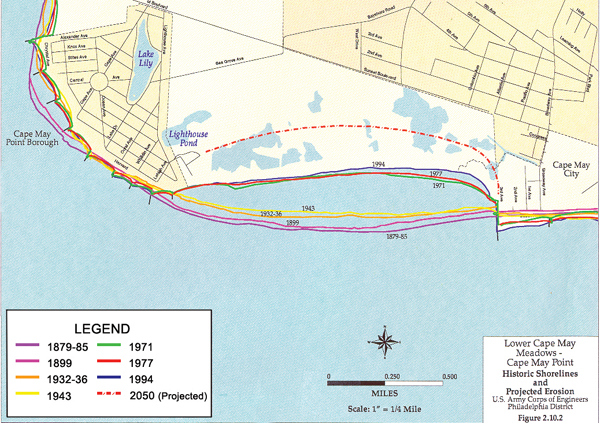 |
| The Indian River Inlet, DE (marinas.com) |
Longshore Transport
Before we get into the nitty gritty of inlets, I want to go over ocean currents briefly. Nearshore currents, for the most part, travel from north to south. This has to do with the angle that the waves hit the beach. These nearshore currents carry sand and other sediments down the coast. This is a term called longshore transport. Jetties are large stone walls that stick out into the ocean. As the currents run into these walls, it loses energy and drops the sand that it was transporting down the coast. On the updrift side of the jetty we get an accumulation of sand. When the current passes by the inlet, it increases in energy and is able to pick up sand to transport. This process causes erosion on the downdrift side of the jetty.
 |
| Diagram showing how longshore transport operates (crd.bc.ca) |
Cape May
The Cape May Inlet jetty was constructed in 1911. It separates the cities of Wildwood and Cape May, NJ. Shortly after its construction, the Cape May Inlet jetty began causing erosion on the Cape May beaches (downdrift of the inlet). You can see the amount of erosion along Cape May in the image below. Note how you can determine the alongshore current direction by looking at the erosion associated with the inlet. In this case the current is moving east to west. Also notice how Wildwood (updrift of inlet) is accumulating sediment on its beaches. The beaches along Wildwood are HUGE because of the jetty.
 |
| Erosion along the Cape May beach cause by the jetty construction in 1911 (Image: Karen Fox, Rebuilding a Beach) |
Assateague Island
Assateague Island is the textbook example of erosion of a beach caused by a jetty construction. In 1933, a hurricane came up the East Coast of the U.S. and caused an inlet to form just south of Ocean City, MD. It was decided to keep the inlet open permanently by constructing a jetty. Construction on the Ocean City Inlet was completed in 1935. Ocean City is located on the updrift side of the inlet, while Assateague Island is located on the downdrift side. Low and behold, Assateague Island started eroding away... big time. Assateague Island is part of the National Park Service, so it is undeveloped and inhabited. So much erosion took place on Assateague Island that the barrier island width actually thinned and began moving landward. Today, Assateague Island has been somewhat stabilized by replenishing the beach occasionally.
 |
| The landward migration of Assateague Island, MD due to the Ocean City Inlet (Beaches and Coasts, 2004) |
Final Word
So are jetties good are bad? Well they're good in the sense that it stabilizes water traffic. Both jettied mentioned in this discussion were stabilized for the use of adjacent Coast Guard stations. The jetties are also used by fishing vessels. Certain industries rely on the stability of inlets. The down side of stabilizing inlets with jetties is that the downdrift beach will be eroded. Inlets are very expensive structures to maintain because of the beach replenishment actions that must be taken on the downdrift side.